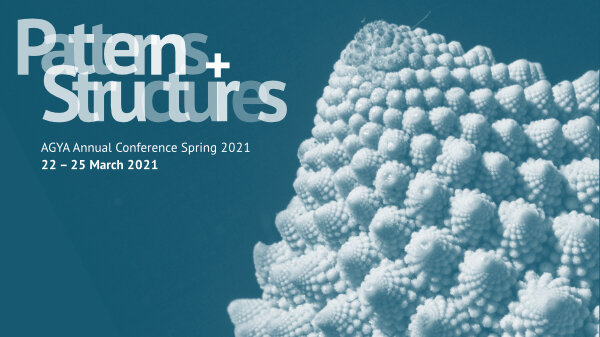From Lists in Literature to Chaos Theory: AGYA Explores Patterns and Structures in Interdisciplinary Research
From Lists in Literature to Chaos Theory: AGYA Explores Patterns and Structures in Interdisciplinary Research
The AGYA Annual Spring Conference took place online from 22 – 25 March 2021 and was vivid proof of AGYA’s constant strive for innovative interdisciplinary research approaches.
Sharing, comparing, combining
Patterns and structures crucially impact our understanding of reality. As fundamental categories, they help us analyse, order, and compare complex phenomena in our material and immaterial environment. They occur in the natural sciences and mathematics as much as in philosophy, music, or literature. AGYA members have therefore chosen “Patterns and Structures in Sciences and Humanities” as the topic of the Annual Spring Conference 2021, aiming to broaden the paths of interdisciplinary discourse.
In a festive opening, AGYA Principal Investigator Prof. Dr. Verena Lepper, AGYA Co-President Dr. Maha Nasr, and AGYA Steering Committee Member Prof. Dr. Marc Ringel welcomed all members, alumni/ae, guests, and friends of AGYA. “Searching for common aspects of patterns and structures in the sciences and humanities can point us in new directions across disciplinary boundaries and strengthen AGYA’s research collaborations.”, said Prof. Dr. Verena Lepper in her welcome speech.
Lists create meaning through their patterns and structures. In his public keynote lecture on ‘The Art of Numeration’, AGYA alumnus Prof. Dr. Bilal Orfali, Sheikh Zayed Chair of Arabic and Islamic Studies at the American University of Beirut/Lebanon, invited the audience to change perspectives: He presented pre-modern Arabic authors’ approaches to collecting words, ideas, and objects, which they then subjected to a system of order. By creating a genealogy, he emphasised that people's enthusiasm and desire for lists belong to our shared heritage.
The relation of order and chaos was further explored in the public panel discussion on ‘Patterns and Structures – An Approach to Interdisciplinary Exchange’. AGYA member Dr. Amro Ali led a discussion with three outstanding guests: Prof. Dr. Ahmed Elwakil, Electrical and Computer Engineering, University of Sharjah/UAE, with expertise in modelling, fractals, and theory of chaos and order, showing that randomness produces surprising patterns of order. Dr. Derrick VanGennep, Physicist at the New England Complex Systems Institute, Boston/USA, presented his recent research collaboration endcoronavirus, showing cultural patterns found in Covid-19 data and infection statistics. Presenting highly interdisciplinary research with an expertise in virology and audiovisual arts, Dr. Sarmistha Talukdar instructor at the Department of Human and Molecular Genetics, Virginia Commonwealth University, Richmond/USA and artist, completed the panel and discussed forms of using patterns in research data to produce art, which may in return inspire research.
Moving online – creating digital encounters
In an exclusive virtual meeting, AGYA members met with Prof. Dr. Dr. h.c. mult. Christoph Markschies, President of the Berlin-Brandenburg Academy of Sciences and Humanities (BBAW) and new Co-Chair of the AGYA Advisory Board. Prof. Dr. Markschies welcomed all members in the name of the AGYA Advisory Board. Representatives of the AGYA Steering Committee and the six AGYA Working Groups then introduced AGYA’s current agenda and collaborative research projects. These range from finding practical solutions for hygiene measures in the current pandemic, teaching STEM in remote areas, analysing German transformation processes from an Arab perspective, empowering women in economically disadvantaged regions, and developing technologies for energy generation in waste management. “I am impressed by the expertise represented within AGYA and by the diversity of issues AGYA members address in their research. We share many interests and I look forward to future joint research activities at the BBAW.”, Prof. Dr. Markschies replied to the AGYA members.
To feature patterns and structures in the arts, AGYA member Dr. Matthias Pasdzierny and Sandra Passaro/Norient curated a video exhibition that explored realities of understanding patterns and structures from a scientific approach. These audio-visual soundscapes were presented in the newly created digital AGYA Liwan, a virtual space that simulates a conference venue and offers the opportunity to connect and engage in joint activities.
The conference program also provided a hands-on workshop held by renowned artist, designer, and researcher Dr. Salman Alhajri, Associate Professor of Graphic Design at Sultan Qaboos University in Oman, on Digital Scientific Drawing. Finally, AGYA members and alumni enjoyed a digital tour of the Museum Barberini in Potsdam in which the guides elaborated on patterns and structures in Impressionist art.
Despite the pandemic – AGYA stands for stable and innovative Arab-German research collaborations
The internal AGYA General Assembly sessions revealed that even in times of travel restrictions and home office, AGYA successfully realised several interdisciplinary research projects in 2020. AGYA members managed to quickly adapt their research practices to the new conditions, maintaining close ties and finding innovative digital forms of cooperation to guarantee fruitful exchange in all fields: From Avant-Garde Arab music to new materials, from practical solutions in the Covid-19 pandemic to questions of climate justice, from mobility for people with handicaps to women’s empowerment in Agriculture: AGYA members tackle a wide range of topics relevant to developing solutions to societal challenges and constitute a growing network of experts across all disciplines.

Date and Venue
22 - 25 March 2021
Online